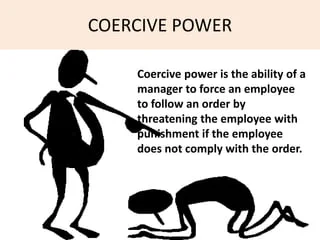Hi all! As we continue our exploration into power bases, it is time to discuss coercive power. Coercive power, at first blush, appears to be a negative power base and if it is used consistently to instill fear, it is. However, if one uses coercive power effectively and responsibly, it becomes a valuable tool in one’s leadership arsenal. In the following, we will define coercive power, discuss its uses, both good and bad, and explain how you can use it to achieve desired outcomes.

Understanding Coercive Power
One can describe coercive power as a type of influence that relies on the use of fear, threats, or punishment to control or manipulate others. Those that use coercive power almost exclusively to influence others, often instill fear in others by leveraging their authority, control over resources, or ability to inflict punishment. By exploiting fear, they aim to maintain dominance and compel compliance from those under their influence.
I remember vividly having a discussion with a supervisor (he was the most despised supervisor on the department) about the environment he created (and his positional authority that gave him the ability to punish others) due to his reliance on and use of coercive power. This supervisor had adversely affected morale because of his constant threats towards and belittling of line-level police officers and professional staff. I had tried to buffer this supervisor’s actions as I reported directly to the supervisor (I was second-in-charge of the police district/substation). Well, things came to a head, so I decided I must speak to him about his management style and the negative impact it had on everyone. I walked into his office and asked to speak to him. He was less than thrilled to see me and reluctantly said “yes.” I then asked him if I could shut his office door and he quickly responded, “Why, you’re not going to beat me up are you?” I was a bit surprised by his response and said, “No, I just want to talk to you about your leadership style.” For the next several minutes, I explained to this supervisor the debilitating impact his management style had on everyone at the station. Not surprisingly, he did not care. In fact, he stated, “I would rather be feared than loved.” I offered suggestions and assistance to him concerning changing his style; however, he had no interest in doing so. Before we ended our discussion, I told him that if he changed or at least attempted to change before he retired (he retired about 18 months after this discussion), many people would forget about his past management style, and they may even like him. However, I also told him that if he continued to manage as usual, when he retired, people would through parties in his honor and not invite him. Well, he did not change and when he retired, my understanding is about 10 people went to his retirement party the department held for him (I did not go). About two weeks later, a few sergeants from the district station through a party in his honor and did not invite him. I believe between 200-300 people showed up at that party to celebrate the fact that the supervisor had retired. I did go to that party, and it was great!!!
One must understand that the use of threats of punishment and/or actual punishment are inherent aspects of coercive power; however, it is essential we understand and know where the line is that separates coercive power from abuse. Coercion becomes abusive when it crosses ethical boundaries, causes harm, or violates rights. Understanding the balance is key to assessing and addressing the potential misuse and/or abuse of coercive power and using coercive power ethically.
Using Coercive Power Ethically
It is imperative that when deciding to use coercion to influence one approaches its use with a strong, ethical framework. Doing so ensures that it is employed responsibly with a focus on maintaining fairness, respect, and the well-being of individuals. Below are some key considerations for using coercive power ethically:
- Justified and Proportionate: The use of coercive power must be justified and proportionate to the situation in which it is used. One should only use coercion when its use is necessary and when alternative approaches are not successful or practical to address the situation.
- Focused on the Behavior, Not the Person: When utilizing coercion, it is essential to maintain a focus on the behavior you are trying to correct, rather than targeting or attacking the person.
- Use Coercive Power Fairly and Impartially: One must use coercive power in a fair, consistent, and impartial manner. Fairness involves ensuring consistent treatment, considering different perspectives, and avoiding favoritism and discriminatory practices.
The Effective Use of Coercive Power
Now that we have discussed the ethical aspects of coercive power, let’s delve into the practical side of its use. How can we use coercive power effectively to achieve our desired outcomes? We can do so by setting clear expectations, using coercive power at the right time, and looking at alternatives to its use.
- Establish and Communicate Expectations: To effectively use coercive power, one must establish and communicate clear expectations and the potential consequences of not meeting the expectations. Clearly defining rules, standards, and desired outcomes helps individuals understand the expectations placed upon them and the consequences they may face for not meeting expectations.
- Time it Right: Timing is key to the effective use of coercive power. It is important to recognize when and where to apply coercion. The use of coercion, in some situations, is necessary to maintain order, enforce rules, or address urgent matters. That stated, it is equally important to use judgment and determine whether another form of influence is more suitable to address the situation.

My college baseball coach, the legendary John Scolinos, was a timing master. We were playing Cal (Berkley) at their baseball stadium. Cal’s fans were brutal on the opposing team and its fans. Numerous rambunctious Cal fans sat right behind our dugout. The fans were giving us the business and I believe many were inebriated. Cal’s dugouts were garden-level style, so when a player would enter the dugout, the player would be face-to-face and intimately close to the fans, within a foot or two. Coach Scolinos had very clear expectations of his players’ demeanor toward fans, the opposing team, and the umpires. Coach preached to us to keep our mouths shut and beat the opposing team with bats, arms, gloves, and the score. Coach also did not allow profanity. Coach disciplined players who violated these rules. Coach ended up sending up a player, “Ziggy,” to pinch hit. When Ziggy’s name was announced, the public announcer and fans began making fun of Ziggy’s name. Ziggy struck out on three straight pitches without swinging. As he walked back to the dugout, the fans were yelling obscenities at Ziggy and as he approached, the dugout there were a couple of fans standing in the bleachers right near the dugout, literally within a foot of the field. These fans were giving Ziggy the business and as Ziggy began to enter the dugout, he yelled at the fans, put his hands up right in their faces, cussed at them, and flipped them off. Coach was standing at the other end of the dugout and saw Ziggy’s reaction to the fans. We all (the players) went silent because we knew Coach’s expectations and Ziggy clearly violated the rules. Well, Coach used his judgment and humor to address the situation instead of punishment. Coach stood there quietly, with his arms folded, and one hand rubbing his chin. Coach paused, slightly shook his head, and then, with his gravely, Dick Tracy-sounding voice, said, “By Golly Ziggy, you’re mad at the world!” Coach then kind of smirked and didn’t say anything more. Coach’s reaction put us all at ease and we all laughed knowing that Ziggy’s fate could have been much worse. Timing is everything!
- Look for Alternative Strategies: While the use of coercive power is effective in certain situations, it is beneficial to explore the use of non-coercive strategies/power bases whenever possible. For example, offering rewards, recognition, autonomy, and other meaningful incentives, may create the needed/wanted motivation, rather than motivation created through fear or punishment. Research has shown that positive reinforcement lasts much longer than negative reinforcement. Exploring alternative power bases rather than using coercive power can foster a positive and empowering environment and minimize the potential negative consequences associated with coercive power.
Wrapping up
Coercive power, when used irresponsibly, excessively, with malice, and to instill fear is detrimental to individual and organizational morale, and most likely will create a hostile and oppressive environment. However, coercive power is a valuable tool when used ethically and responsibly. By recognizing the line between coercion and abuse, focusing on behavior rather than attacking the person, and employing coercion proportionately and justifiably, leaders can effectively harness its potential. The ethical use of coercive power requires maintaining fairness, impartiality, and respect for the rights and well-being of others.
To use coercive power effectively, leaders must establish clear expectations, communicate consequences, and use the power wisely. That stated, whenever possible, exploring alternative non-coercive strategies for motivation is encouraged. By offering incentives, recognition, and autonomy, a leader can create a positive and empowering environment and minimize the negative consequences associated with coercive power.
